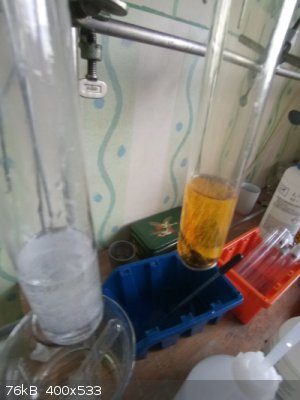| Pages:
1
2 |
teodor
National Hazard
   
Posts: 872
Registered: 28-6-2019
Location: Heerenveen
Member Is Offline
|
|
OK, I've tried that, eventually.
I must admit that the usage of aqua regia vs 36% HCl has no speed benefit.
I did the experiment by dissolving pieces of tin metal I created by dropping the melted metal through a small glass funnel into glicerol and water
(they are quite similar, have a shiny surface; the usage of glycerol is more convenient because it doesn't create kind of steam explosions but do it
under ventilation).
I used both big and small pieces.
The aqua regia was prepared by mixing 6 ml of 36% HCl and 2 ml of azeotropic HNO3 (the fraction distilled on 121C).
Both tubes show good reaction but aqua regia seams produce 2-3 times more bubbles, so the speed is higher. But I noticed it is just because this
reaction is exotermic (it oxidise tin to valence IV) and when I heated the second (pure HCl) tube to the same temperature on a water bath the speed of
bubbles was almos the same:

Also I tried to dissolve KNO3 in 36 HCl, but it didn't. So, I've prepared solution of KNO3 in boiling water and have poured it into 36% HCl. It
immediately produced precipitation of KCl and created some mixture with the same color as the genuine aqua regia, but this need to be decanted from
KCl crystalls because they prevent to use it for dissolving of metals.
Generally, with or without usage of water bath, 36% HCl attacks tin pretty well, I can compare with its action on chrome metal, well a bit slower but
still doable.
If you have different experience that is probably due to usage of some alloy, not a pure ("crying") tin.
[Edited on 31-10-2020 by teodor]
|
|
|
MidLifeChemist
Hazard to Others
  
Posts: 192
Registered: 4-7-2019
Location: West Coast USA
Member Is Offline
Mood: precipitatory
|
|
Quote: Originally posted by SplendidAcylation  |
I have tried the aluminium + copper (II) reaction, and I was indeed surprised to find it didn't work, I just assumed it was due to the passivation
layer |
If you add a pinch of table salt, aluminum + copper (II) happens quickly, within 30 minutes. I've produced a good amount of copper that way. Without
the pinch of NaCl, nothing happens.
|
|
|
| Pages:
1
2 |
|